Foutse Khomh
Jack
FairFLRep: Fairness aware fault localization and repair of Deep Neural Networks
Aug 11, 2025Abstract:Deep neural networks (DNNs) are being utilized in various aspects of our daily lives, including high-stakes decision-making applications that impact individuals. However, these systems reflect and amplify bias from the data used during training and testing, potentially resulting in biased behavior and inaccurate decisions. For instance, having different misclassification rates between white and black sub-populations. However, effectively and efficiently identifying and correcting biased behavior in DNNs is a challenge. This paper introduces FairFLRep, an automated fairness-aware fault localization and repair technique that identifies and corrects potentially bias-inducing neurons in DNN classifiers. FairFLRep focuses on adjusting neuron weights associated with sensitive attributes, such as race or gender, that contribute to unfair decisions. By analyzing the input-output relationships within the network, FairFLRep corrects neurons responsible for disparities in predictive quality parity. We evaluate FairFLRep on four image classification datasets using two DNN classifiers, and four tabular datasets with a DNN model. The results show that FairFLRep consistently outperforms existing methods in improving fairness while preserving accuracy. An ablation study confirms the importance of considering fairness during both fault localization and repair stages. Our findings also show that FairFLRep is more efficient than the baseline approaches in repairing the network.
SDLog: A Deep Learning Framework for Detecting Sensitive Information in Software Logs
May 20, 2025Abstract:Software logs are messages recorded during the execution of a software system that provide crucial run-time information about events and activities. Although software logs have a critical role in software maintenance and operation tasks, publicly accessible log datasets remain limited, hindering advance in log analysis research and practices. The presence of sensitive information, particularly Personally Identifiable Information (PII) and quasi-identifiers, introduces serious privacy and re-identification risks, discouraging the publishing and sharing of real-world logs. In practice, log anonymization techniques primarily rely on regular expression patterns, which involve manually crafting rules to identify and replace sensitive information. However, these regex-based approaches suffer from significant limitations, such as extensive manual efforts and poor generalizability across diverse log formats and datasets. To mitigate these limitations, we introduce SDLog, a deep learning-based framework designed to identify sensitive information in software logs. Our results show that SDLog overcomes regex limitations and outperforms the best-performing regex patterns in identifying sensitive information. With only 100 fine-tuning samples from the target dataset, SDLog can correctly identify 99.5% of sensitive attributes and achieves an F1-score of 98.4%. To the best of our knowledge, this is the first deep learning alternative to regex-based methods in software log anonymization.
Prism: Dynamic and Flexible Benchmarking of LLMs Code Generation with Monte Carlo Tree Search
Apr 10, 2025Abstract:The rapid advancement of Large Language Models (LLMs) has outpaced traditional evaluation methods. Static benchmarks fail to capture the depth and breadth of LLM capabilities and eventually become obsolete, while most dynamic approaches either rely too heavily on LLM-based evaluation or remain constrained by predefined test sets. We introduce Prism, a flexible, dynamic benchmarking framework designed for comprehensive LLM assessment. Prism builds on three key components: (1) a tree-based state representation that models evaluation as a Markov Decision Process, (2) a Monte Carlo Tree Search algorithm adapted to uncover challenging evaluation scenarios, and (3) a multi-agent evaluation pipeline that enables simultaneous assessment of diverse capabilities. To ensure robust evaluation, Prism integrates structural measurements of tree exploration patterns with performance metrics across difficulty levels, providing detailed diagnostics of error patterns, test coverage, and solution approaches. Through extensive experiments on five state-of-the-art LLMs, we analyze how model architecture and scale influence code generation performance across varying task difficulties. Our results demonstrate Prism's effectiveness as a dynamic benchmark that evolves with model advancements while offering deeper insights into their limitations.
Evaluating and Enhancing Segmentation Model Robustness with Metamorphic Testing
Apr 03, 2025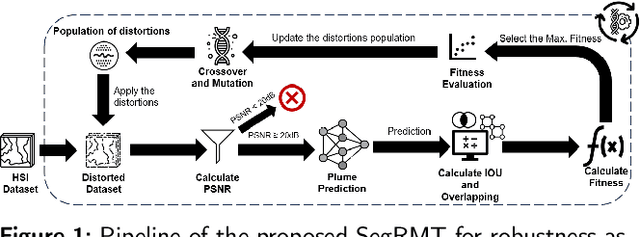
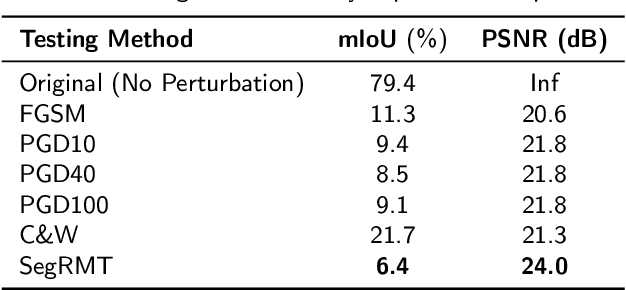
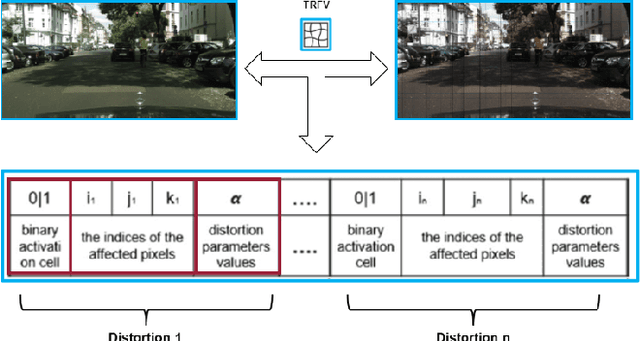

Abstract:Image segmentation is critical for applications such as medical imaging, augmented reality, and video surveillance. However, segmentation models often lack robustness, making them vulnerable to adversarial perturbations from subtle image distortions. In this work, we propose SegRMT, a metamorphic testing approach that leverages genetic algorithms (GA) to optimize sequences of spatial and spectral transformations while preserving image fidelity via a predefined PSNR threshold. Using the Cityscapes dataset, our method generates adversarial examples that effectively challenge the DeepLabV3 segmentation model. Our experiments show that SegRMT reduces DeepLabV3's mean Intersection over Union (mIoU) to 6.4%, outperforming other adversarial baselines that decrease mIoU to between 8.5% and 21.7%. Furthermore, when used for adversarial training, SegRMT boosts model performance, achieving mIoU improvements up to 73% on dedicated adversarial datasets and increasing cross-adversarial mIoU to 53.8%, compared to only 2%-10% for other methods. These findings demonstrate that SegRMT not only simulates realistic image distortions but also enhances the robustness of segmentation models, making it a valuable tool for ensuring reliable performance in safety-critical applications.
Representation Improvement in Latent Space for Search-Based Testing of Autonomous Robotic Systems
Mar 26, 2025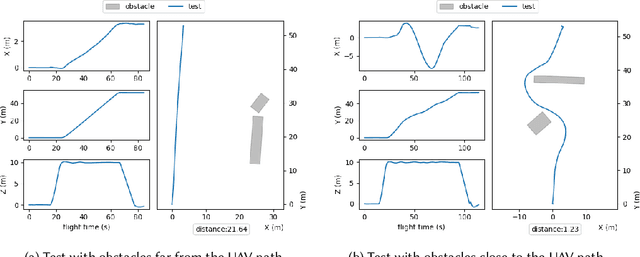

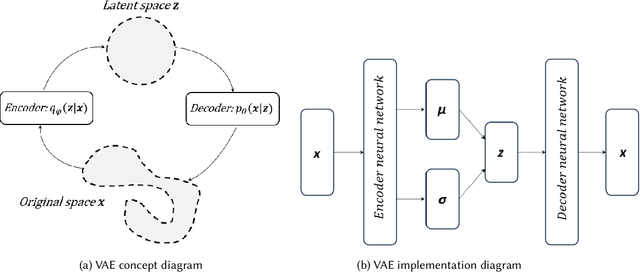
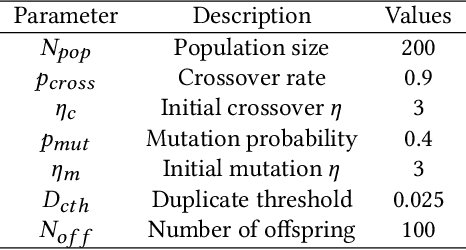
Abstract:Testing autonomous robotic systems, such as self-driving cars and unmanned aerial vehicles, is challenging due to their interaction with highly unpredictable environments. A common practice is to first conduct simulation-based testing, which, despite reducing real-world risks, remains time-consuming and resource-intensive due to the vast space of possible test scenarios. A number of search-based approaches were proposed to generate test scenarios more efficiently. A key aspect of any search-based test generation approach is the choice of representation used during the search process. However, existing methods for improving test scenario representation remain limited. We propose RILaST (Representation Improvement in Latent Space for Search-Based Testing) approach, which enhances test representation by mapping it to the latent space of a variational autoencoder. We evaluate RILaST on two use cases, including autonomous drone and autonomous lane-keeping assist system. The obtained results show that RILaST allows finding between 3 to 4.6 times more failures than baseline approaches, achieving a high level of test diversity.
An Efficient Model Maintenance Approach for MLOps
Dec 05, 2024Abstract:In recent years, many industries have utilized machine learning models (ML) in their systems. Ideally, machine learning models should be trained on and applied to data from the same distributions. However, the data evolves over time in many application areas, leading to data and concept drift, which in turn causes the performance of the ML models to degrade over time. Therefore, maintaining up to date ML models plays a critical role in the MLOps pipeline. Existing ML model maintenance approaches are often computationally resource intensive, costly, time consuming, and model dependent. Thus, we propose an improved MLOps pipeline, a new model maintenance approach and a Similarity Based Model Reuse (SimReuse) tool to address the challenges of ML model maintenance. We identify seasonal and recurrent distribution patterns in time series datasets throughout a preliminary study. Recurrent distribution patterns enable us to reuse previously trained models for similar distributions in the future, thus avoiding frequent retraining. Then, we integrated the model reuse approach into the MLOps pipeline and proposed our improved MLOps pipeline. Furthermore, we develop SimReuse, a tool to implement the new components of our MLOps pipeline to store models and reuse them for inference of data segments with similar data distributions in the future. Our evaluation results on four time series datasets demonstrate that our model reuse approach can maintain the performance of models while significantly reducing maintenance time and costs. Our model reuse approach achieves ML performance comparable to the best baseline, while being 15 times more efficient in terms of computation time and costs. Therefore, industries and practitioners can benefit from our approach and use our tool to maintain the performance of their ML models in the deployment phase to reduce their maintenance costs.
Fault Localization in Deep Learning-based Software: A System-level Approach
Nov 12, 2024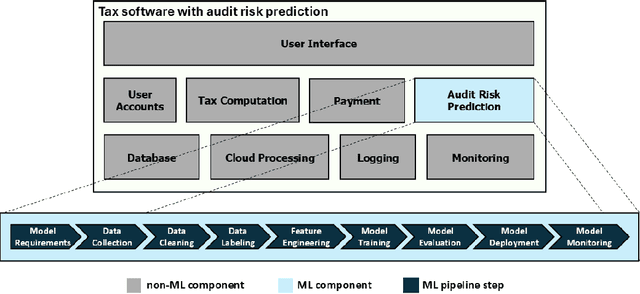
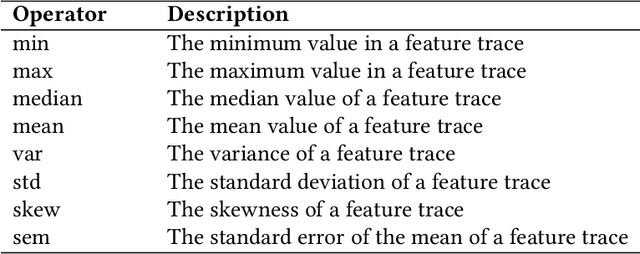
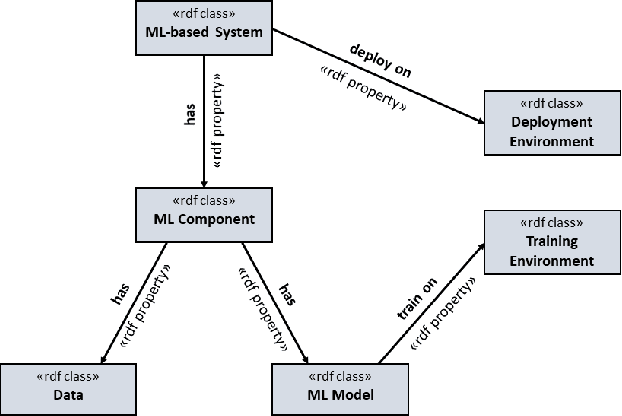
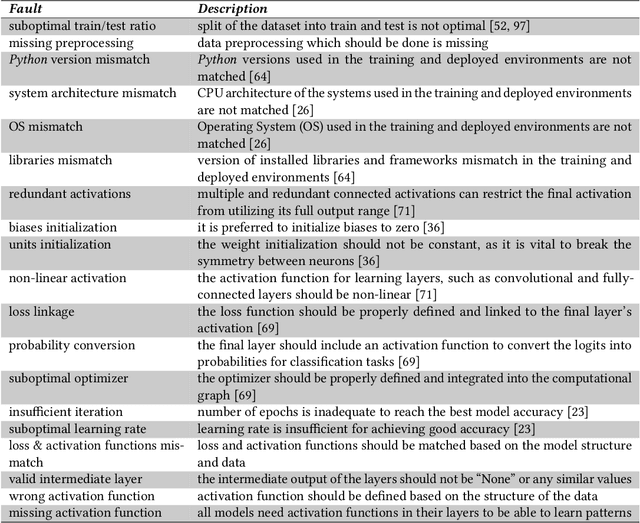
Abstract:Over the past decade, Deep Learning (DL) has become an integral part of our daily lives. This surge in DL usage has heightened the need for developing reliable DL software systems. Given that fault localization is a critical task in reliability assessment, researchers have proposed several fault localization techniques for DL-based software, primarily focusing on faults within the DL model. While the DL model is central to DL components, there are other elements that significantly impact the performance of DL components. As a result, fault localization methods that concentrate solely on the DL model overlook a large portion of the system. To address this, we introduce FL4Deep, a system-level fault localization approach considering the entire DL development pipeline to effectively localize faults across the DL-based systems. In an evaluation using 100 faulty DL scripts, FL4Deep outperformed four previous approaches in terms of accuracy for three out of six DL-related faults, including issues related to data (84%), mismatched libraries between training and deployment (100%), and loss function (69%). Additionally, FL4Deep demonstrated superior precision and recall in fault localization for five categories of faults including three mentioned fault types in terms of accuracy, plus insufficient training iteration and activation function.
Towards Optimizing SQL Generation via LLM Routing
Nov 06, 2024Abstract:Text-to-SQL enables users to interact with databases through natural language, simplifying access to structured data. Although highly capable large language models (LLMs) achieve strong accuracy for complex queries, they incur unnecessary latency and dollar cost for simpler ones. In this paper, we introduce the first LLM routing approach for Text-to-SQL, which dynamically selects the most cost-effective LLM capable of generating accurate SQL for each query. We present two routing strategies (score- and classification-based) that achieve accuracy comparable to the most capable LLM while reducing costs. We design the routers for ease of training and efficient inference. In our experiments, we highlight a practical and explainable accuracy-cost trade-off on the BIRD dataset.
In-Simulation Testing of Deep Learning Vision Models in Autonomous Robotic Manipulators
Oct 25, 2024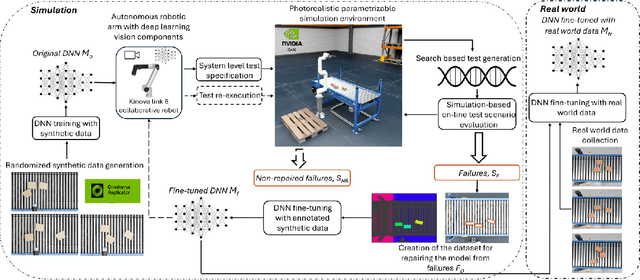

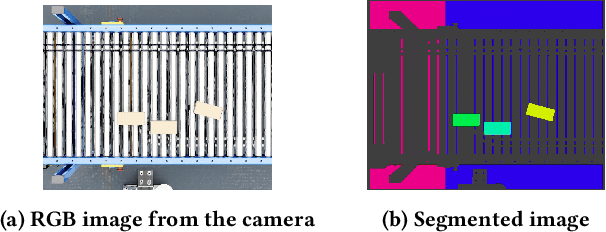

Abstract:Testing autonomous robotic manipulators is challenging due to the complex software interactions between vision and control components. A crucial element of modern robotic manipulators is the deep learning based object detection model. The creation and assessment of this model requires real world data, which can be hard to label and collect, especially when the hardware setup is not available. The current techniques primarily focus on using synthetic data to train deep neural networks (DDNs) and identifying failures through offline or online simulation-based testing. However, the process of exploiting the identified failures to uncover design flaws early on, and leveraging the optimized DNN within the simulation to accelerate the engineering of the DNN for real-world tasks remains unclear. To address these challenges, we propose the MARTENS (Manipulator Robot Testing and Enhancement in Simulation) framework, which integrates a photorealistic NVIDIA Isaac Sim simulator with evolutionary search to identify critical scenarios aiming at improving the deep learning vision model and uncovering system design flaws. Evaluation of two industrial case studies demonstrated that MARTENS effectively reveals robotic manipulator system failures, detecting 25 % to 50 % more failures with greater diversity compared to random test generation. The model trained and repaired using the MARTENS approach achieved mean average precision (mAP) scores of 0.91 and 0.82 on real-world images with no prior retraining. Further fine-tuning on real-world images for a few epochs (less than 10) increased the mAP to 0.95 and 0.89 for the first and second use cases, respectively. In contrast, a model trained solely on real-world data achieved mAPs of 0.8 and 0.75 for use case 1 and use case 2 after more than 25 epochs.
Toward Debugging Deep Reinforcement Learning Programs with RLExplorer
Oct 06, 2024
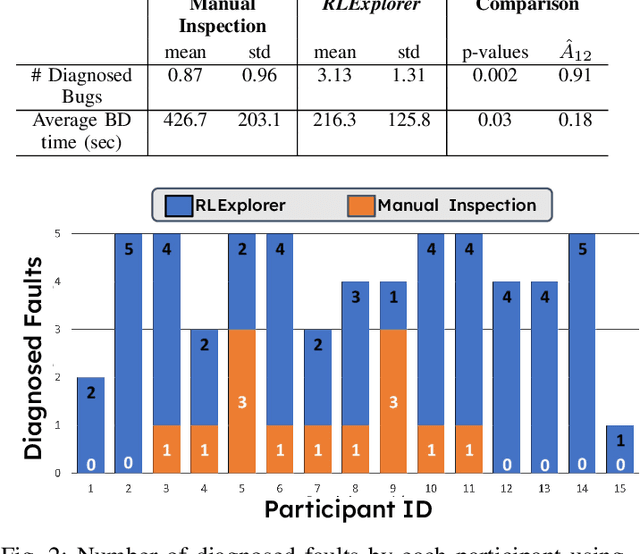
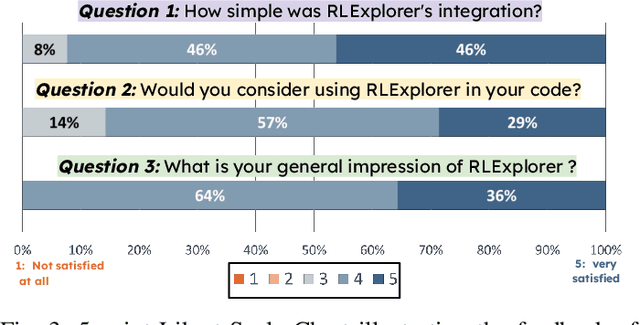
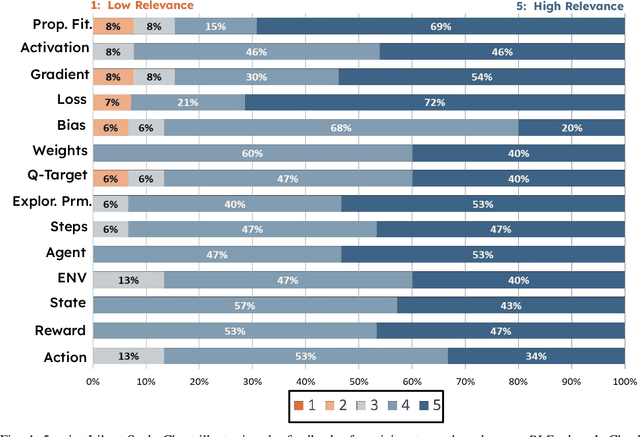
Abstract:Deep reinforcement learning (DRL) has shown success in diverse domains such as robotics, computer games, and recommendation systems. However, like any other software system, DRL-based software systems are susceptible to faults that pose unique challenges for debugging and diagnosing. These faults often result in unexpected behavior without explicit failures and error messages, making debugging difficult and time-consuming. Therefore, automating the monitoring and diagnosis of DRL systems is crucial to alleviate the burden on developers. In this paper, we propose RLExplorer, the first fault diagnosis approach for DRL-based software systems. RLExplorer automatically monitors training traces and runs diagnosis routines based on properties of the DRL learning dynamics to detect the occurrence of DRL-specific faults. It then logs the results of these diagnoses as warnings that cover theoretical concepts, recommended practices, and potential solutions to the identified faults. We conducted two sets of evaluations to assess RLExplorer. Our first evaluation of faulty DRL samples from Stack Overflow revealed that our approach can effectively diagnose real faults in 83% of the cases. Our second evaluation of RLExplorer with 15 DRL experts/developers showed that (1) RLExplorer could identify 3.6 times more defects than manual debugging and (2) RLExplorer is easily integrated into DRL applications.
 Add to Chrome
Add to Chrome Add to Firefox
Add to Firefox Add to Edge
Add to Edge